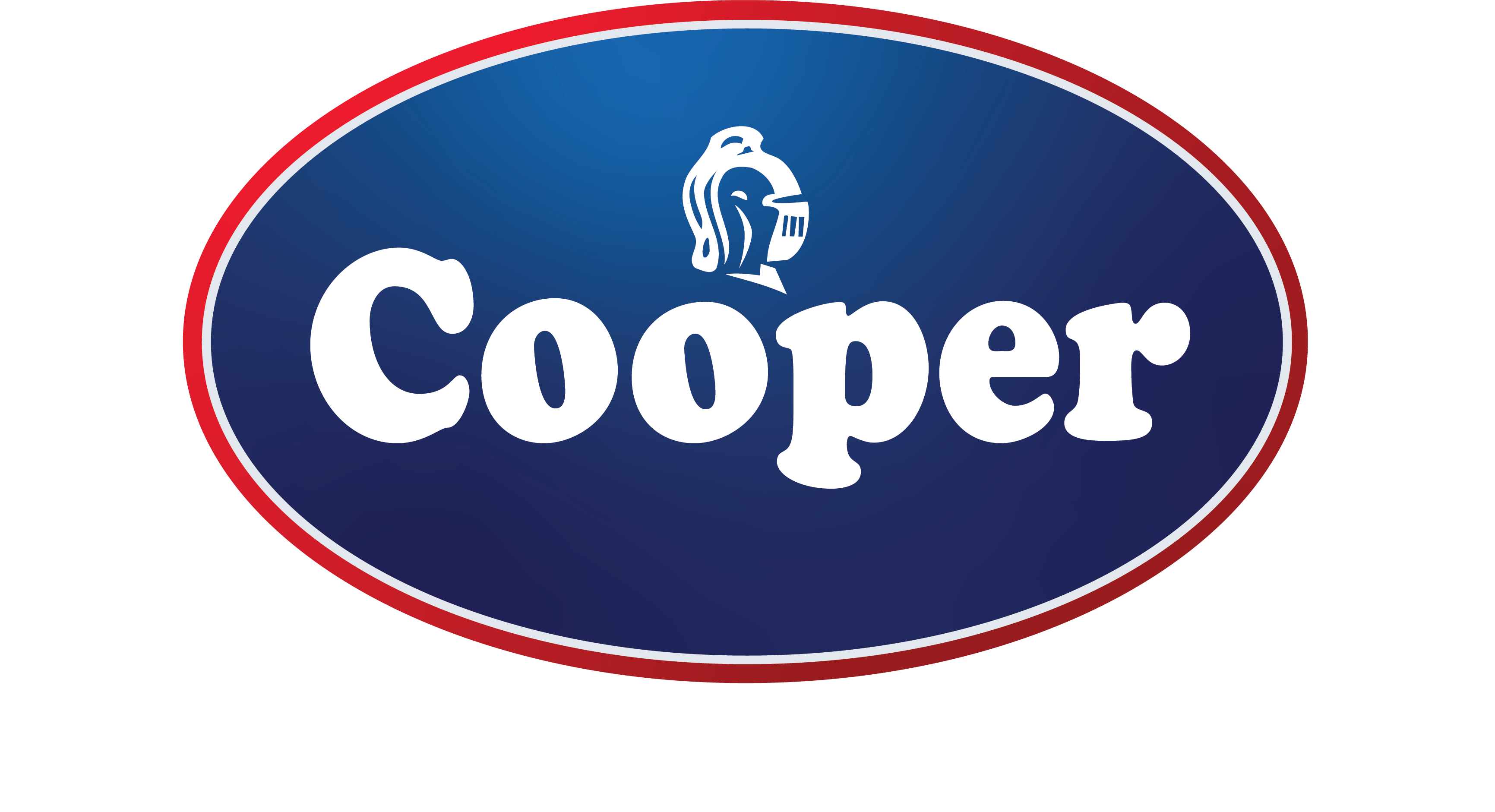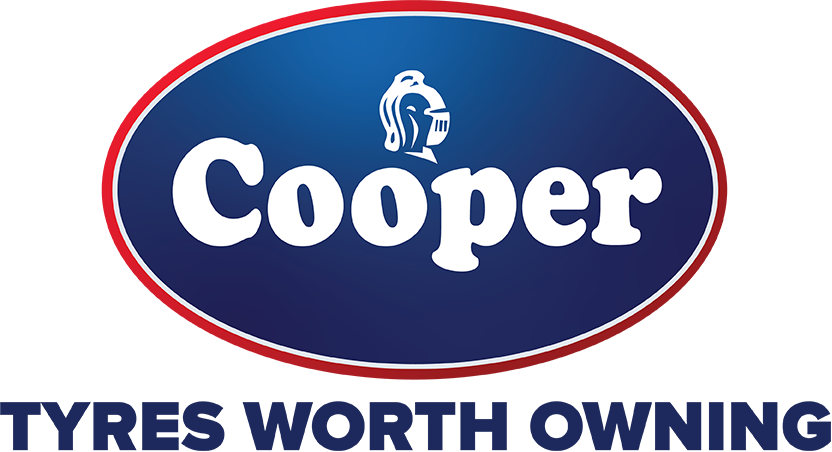XDrive Moreton Island Adventure
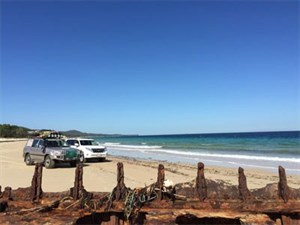
Our recent trip to Moreton Island on the weekend of the 15th to the 17th May 2015, was undertaken as part of a prize from one of our sponsors and we were engaged to take the prizewinners on an adventure.
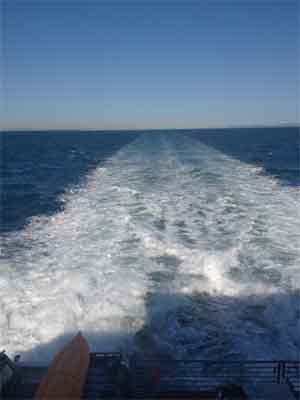
The trip was over quite quickly, even though it did take 90 minutes. As usual disembarking from the ferry was quicker than loading and after hitting the beach, just North of Tangalooma, originally part of the old whaling station, we turned sharp left and headed North to our destination, Bulwer.
The run up the beach was pleasant with an outgoing tide and plenty of sand to drive on. We made the quick 30 minute run up the beach, stopping to view the concrete ‘gun placements’, which were a remnant from the second world war, when Moreton Island was a strategic location to protect Brisbane from a Japanese air strike. During its peak 900 troops were stationed on Moreton Island, to protect the approaches to the Port of Brisbane, with both anti-‐aircraft guns and mine control buildings
Moving further along, the coastline, we stopped to look at the rain falling over the Sunshine Coast and we could see the Glasshouse Mountains against the skyline, a similar view which must have presented itself to Captain Cook on his voyage as we looked across to Redcliffe, Deception Bay and further towards the southern tip of Bribie Island.
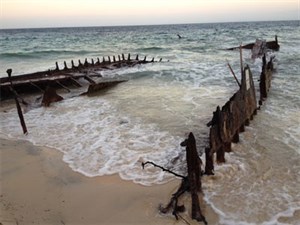
We had booked to stay in the permanent tents situated amongst the trees. These tents take camping to a whole different level of luxury and are known as ‘glamping’ with comfortable beds and their own ‘en-suite’, we quickly took care of the paperwork and unloaded some of our supplies and clothing into the tents. We also put some of our supplies into the fridges in the ‘communal area’, which has all the cooking facilities and space to eat and relax.
Since Steven, had elected to catch the later ferry across to the island, due to work commitments, we had to make the return journey to Tangalooma to fetch him. We took a slightly different route and opted to travel the inland track and visit Cape Moreton and the Lighthouse before returning to Tangalooma and the ferry.
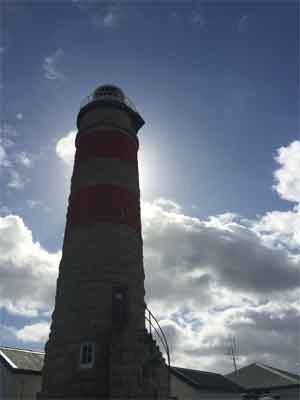
We watched the ferry ‘beach’ and unload another group of happy tourists and campers onto the island. All the vehicles disembarking and scurrying off in various different directions to set up their own campsites for the weekend.
After meeting Steven, we decided to visit Tangalooma and look around. Since the beach access in front of the resort is blocked off from vehicular traffic, we parked up as close to the dunes as possible and walked the short distance to the resort.
We looked around and enjoyed a quick drink, before returning to our vehicles and once again making the short journey up the beach to our own camp.
As the tide had now turned and it was heading for ‘high tide’ we had to get going quickly and as the light was starting to fade we would drive the last few kilometers with our lights on. The beach had taken quite a pounding with some high winds and surf over the week prior to our arrival, so when the tide was in, there was very little beach left to drive on and we had to drive on the narrow verge above the high water mark. This proved a little difficult at times as this became a little too narrow for our vehicles and we had to ‘drop’ of the rather steep ledge onto the sand and make sure that our timing was just right to run between the waves as they rushed in. Our novice drivers were on a quick learning curve although to their credit, they followed our instructions and shadowed our vehicles every move and safely negotiated some rather large and awkward ‘drop-‐offs’ and washaways. We even had to backtrack a little as we had to drop into the streambed at one point as the drop off was just a little too steep. A quick turn onto the beach and a race against the tide saw us splash through eventually arriving at the beach exit to Bulwer with only a few minutes to spare, before the ‘road’ would have been impassable until the tide turned once again.
We settled back into our camp and cooked a lovely dinner and then sat around talking until quite late. It began raining quite heavily and it was nice to lie back in the comfort of a proper bed listening to the rain on the roof of the tent. Next morning, we woke nice and early, we cooked breakfast and once again had to return to Tangalooma as this time we were meeting Paul, who had arranged to come across on the ferry and join us.
The run back down the beach, showed just how high the tide had come up the previous night and how the beach had once again taken a beating from the rough weather. Although this time we did not have to run the gauntlet of the waves.
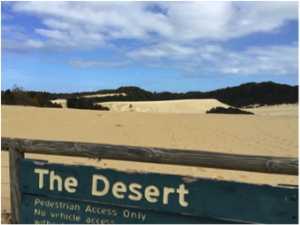
Paul, in the meantime had disembarked and called us on the mobile phone. Don’t rely on mobile reception whilst travelling around, as this was a classic example of how unreliable mobile phones are, when travelling. After many calls backwards and forwards and a few runs through Middle Road, we eventually met up with Paul on the Eastern Beach. Unfortunately, the wind was not being kind and it was blowing a gale on this side of the island.
We decided to travel further south to once again look at some of the artillery points from the second world war and on the way down , we passed the skull of a whale, which had been washed up on the beach. Driving on the beach after the rain, really does not present any challenge, the main issues are to try and keep you speed down to a reasonable level and look out for any washaways or other items which may have been discarded or washed up on the beach. At this particular time of year we did not have to worry too much about others on the beach, however, in season, looking out for people walking and fishing or simply sunbathing should be a priority. People often forget that they cannot easily hear vehicles above the noise of the wind and the waves and people are also easily distracted, so as a Four Wheel Drive driver, it is our job to look out for other people on the beach.
We had a quick stop to look at some of the ruins from WW11 and then we were off again, heading for the lagoon further south and some shelter from the wind so we could enjoy lunch.
We finally found a spot a little inland and sheltered behind the Mirapool Lagoon. Paul informed us that his vehicle had just ‘thrown a drive belt’. So whilst we prepared a quick lunch of some sandwiches and cold meats and salads, some of the guys tried their hand at a bit of softball, whilst Dave, Paul and myself diagnosed the issue on Paul’s vehicle.
The Mazda BT50, has two drive belts, one had broken completely and the other was hanging on by a very small portion. We decided to loosen the belt slightly to take a bit of tension out of the belt, in order to hopefully nurse the vehicle back to the middle of the island. Since we were so close to Kooringal, the most southern town on the island, we decided to take a chance and see if we could source perhaps one belt from there. However, luck was not on our side and there was no hope of finding a belt here. We decided to take a slow drive back up the western beach and hopefully nurse the vehicle back to Tangalooma.
Luck was again not on our side, as before we had even entered onto the beach, the second belt cried enough and snapped as well. This left us no option but to tow Paul back up the beach. We quickly took out our trusty towrope to tow Paul.
We hooked up the rope and once again with the use of our hand held two-way radios, we were able to communicate with Paul and tow him safely. Whilst towing the Mazda BT50 did place more strain on our Toyota LandCrusier. Once we got the vehicle up to a comfortable speed, we locked the Torque Convertor up in third gear with the flick of a switch and watched the temperature of our automatic transmission sit at a comfortable 75 degrees, as we monitored all the vital signs on our gauges. We were confident that the oils that we were using in our LandCruiser would keep everything running smoothly as we had recently serviced our vehicle and replaced all the fluids with top of the line fully synthetic products, including the automatic transmission fluid as well as the engine oil and the transfer gearbox and differentials. Unfortunately, most manufacturers have ‘sealed for life’ automatic transmissions and people neglect to service these components.
Remember our Four Wheel Drive vehicles are subject to more extreme conditions than ordinary vehicles and all oils should be replaced on a regular basis. I live by the old adage ‘oils are cheap, engines and mechanical components are expensive’. Apart from our oils and fluid we also replace all the filters. We also carry a complete hose and belt kit to suit our vehicle and this is supplied with all the correct components in a convenient bag, which is easily stored under the seat and provides peace of mind should anything happen on the trail.
It was actually a rather pleasant drive up the beach to Tangalooma, however, we were ever mindful of the tides and had to get a bit of a move on if we did not want to get stuck in the middle of the island. On reaching Tangalooma Resort, we thought that we would try our luck once again and ask if they had a spare belt for the Mazda. Our luck was in this time, as they did indeed have a belt that fitted and after a bit of a ‘wiggle’ we at least had one belt on and the Mazda could be driven under it’s own power. It was also getting a bit late in the afternoon and the management kindly opened the gate and allowed us to traverse through the back of the resort, thereby cutting out the bypass road and saving us a lot of timeand effort, which was greatly appreciated.
Once back on the other side of the resort, it was a quick run once again up the beach back to or campsite.
Paul had an interesting talk on the products that they supply and showed us the set-up of his own vehicle with regards to a new product, which is essentially a ‘dual battery system’, set up and ready to go. With various options available from USB to cigarette lighter sockets and even their own unique socket which stops the leads from falling out due to vibration.
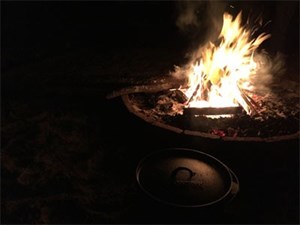
The rain came shortly after and so we once again retreated to the shelter of the dining area and again returned to our various discussions. Paul arranged to undertake a spot of early morning fishing and so we all retired to bed.
Sunday, was a little better, the wind from the previous night had dropped and the rain had eased up. Once again the wet sand was easy going for the vehicles and so after packing up we headed back towards Tangalooma. Todd and the guys wanted to try some fishing we stopped off at the wrecks to give the fishing a go. Fawzie decided that he wanted to give snorkeling on the wrecks a try and so donned his wetsuits and mask and snorkel and entered the water. The swim across to the wrecks did not look far from a spectators point of view but we did notice that Fawzie was getting smaller and smaller as he made his way across, he was also getting more and more tired and eventually opted for a ride in an inflatable boat that was running up and down between the wrecks. After a short ride in the boat, he was dropped off on the wreck and drifted down past all the wrecks looking at the sea life. He did end up a considerable way down the beach, when he finally got out of the water and had a fair distance to walk back to where we were parked. This just showed how fast and strong the current was, even on a relatively calm day.
The ferry for the return arrived and everyone lined up on the beach to wait his and her turn to drive on. We finally loaded up and the ramp behind was drawn up and we proceeded towards Brisbane, our XDrive Moreton Island Adventure was fast coming to an end.
After parking and securing the vehicles we once again made our way upstairs to sit and chat about our weekend. The guys had progressed very well from their novice status in the beginning, in fact they even had to hire a Four Wheel Drive, vehicle for the weekend as no one in the group owned one. We did not get stuck once the entire weekend.
Dave once again, kindly went down below and re-inflated all our tyres prior to disembarking and taking the road home.
Once the ferry docked, we all loaded up and disembarked, meeting just round the corner to finally say our goodbyes for the weekend.
When we arrived home, I quickly placed our batteries on our smart charger, to ensure that we were fully charged and ready to go again at a moments notice. Having a smart charger, ensures that the batteries are kept at their optimum charge and therefore ensure that our batteries will last longer and work properly.
It was a great trip and thanks to our sponsor and to all those that made the trip possible.
